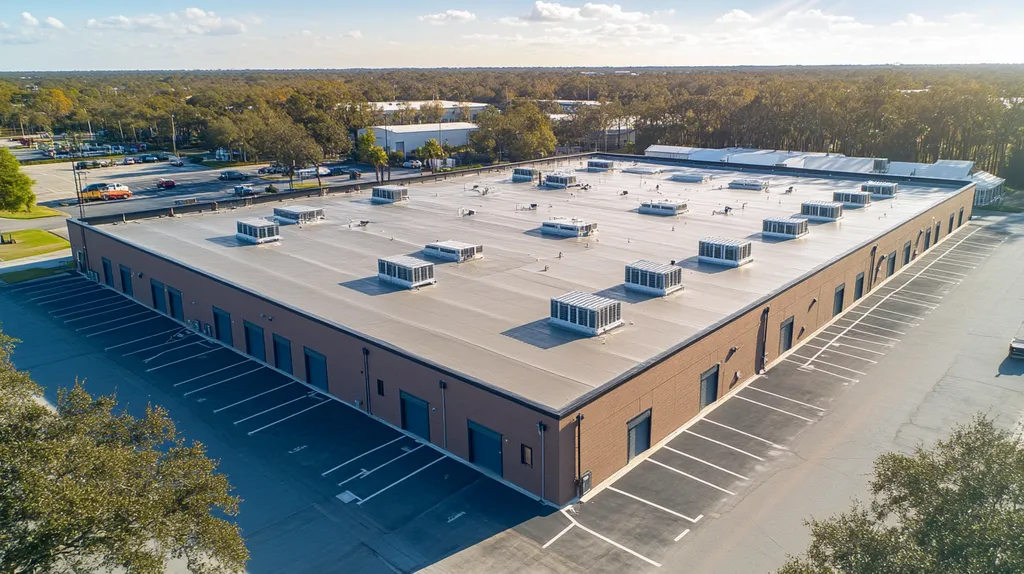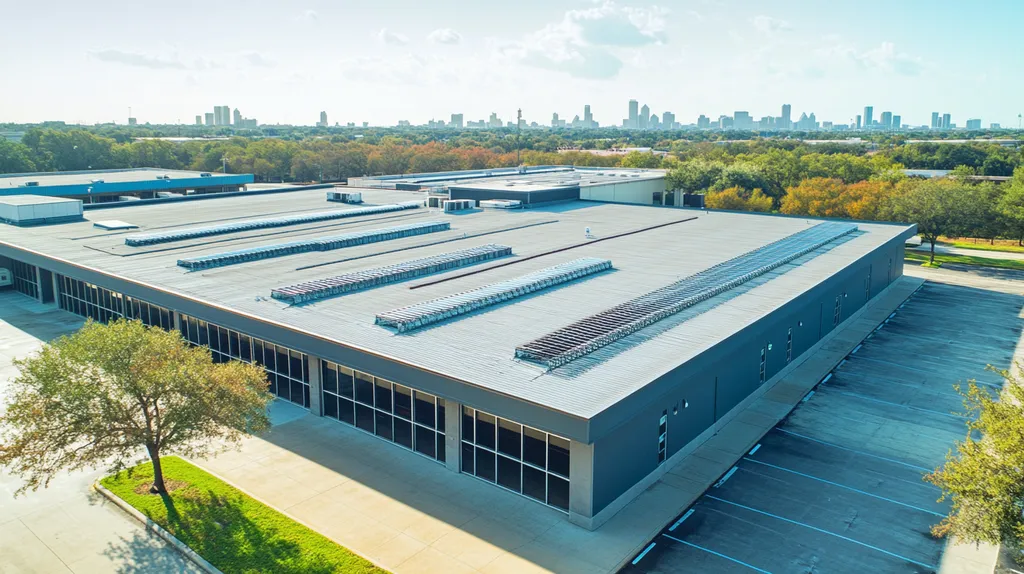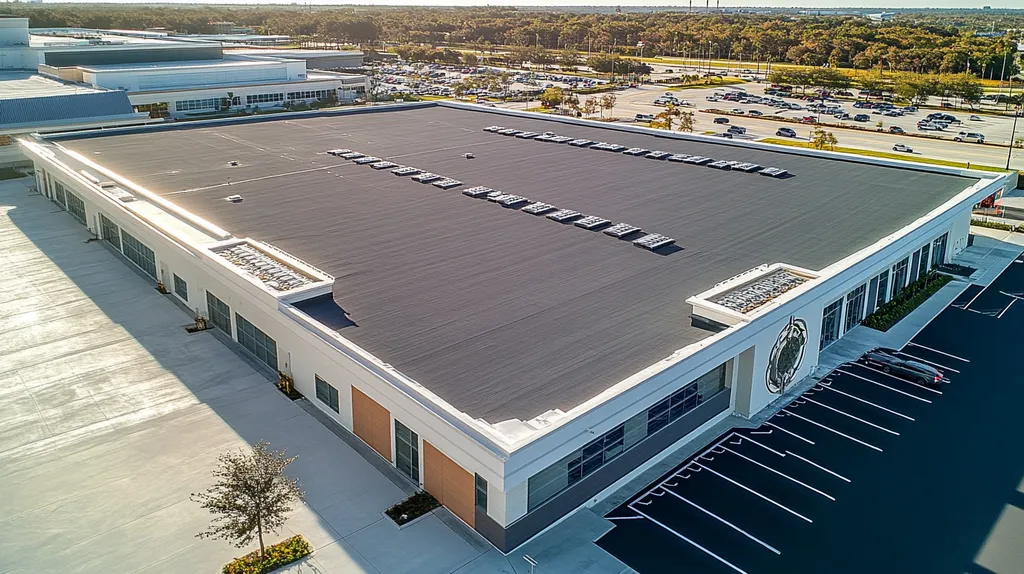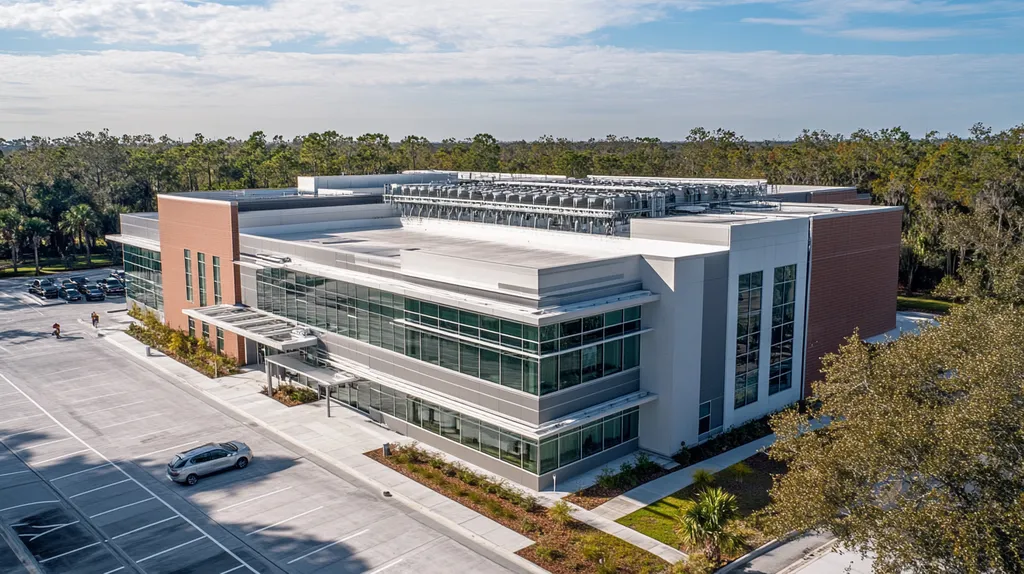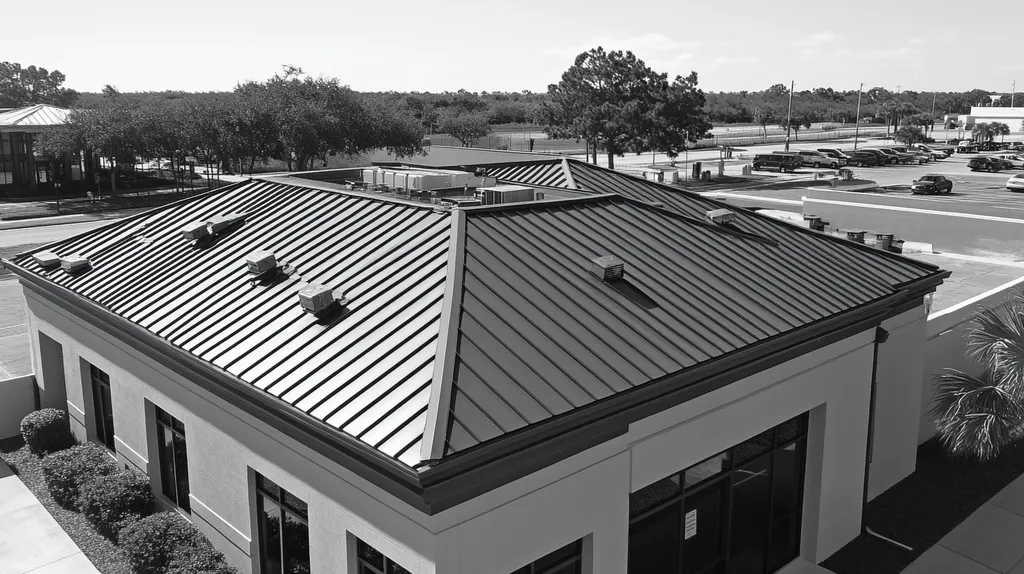Commercial roofing permit delays cost U.S. property owners over $2.1 billion annually in project overruns and emergency repairs, yet regulatory practices continue to prioritize paperwork over performance.
Current permit systems, originally designed for residential construction, fail to address the complex needs of modern commercial facilities where even minor delays can cascade into major business disruptions.
This analysis examines how outdated regulations, fragmented requirements, and missed opportunities for innovation create unnecessary barriers to safe, efficient commercial roof installations while increasing costs and risks for property owners.
SECTION 1: CURRENT PRACTICES
Recent industry data shows that commercial roofing permit delays cost property owners an average of $10,000 per month in project overruns. These inefficiencies stem from a fragmented regulatory landscape where permit requirements can vary dramatically between neighboring jurisdictions. The complexity often forces property owners to navigate conflicting requirements, excessive paperwork, and inconsistent material standards that impact both cost and quality.
Permit Application Variability Across Jurisdictions
The disparity in permit requirements between jurisdictions creates significant challenges for property owners managing multi-location portfolios. While one city might require detailed structural analysis and wind uplift calculations, an adjacent municipality may only need basic documentation and plan reviews.
These variations extend beyond mere paperwork differences. Some jurisdictions mandate specific inspection schedules throughout installation, while others only require final inspections, creating uncertainty in project timelines and costs.
The impact of these inconsistencies affects both large and small projects. A simple roof repair in one jurisdiction might require minimal permitting, while the same repair elsewhere could trigger extensive engineering reviews and documentation.
This regulatory patchwork often forces property owners to maintain multiple compliance strategies, increasing administrative overhead and project complexity.
Overemphasis on Paperwork Over Performance Standards
Current permit processes typically prioritize documentation volume over meaningful quality indicators. Property owners frequently face requirements to submit extensive paperwork that has little bearing on actual roof performance or longevity.
The focus on administrative compliance often overshadows critical performance factors like material compatibility, drainage design, and energy efficiency. This misalignment can result in approved installations that meet all permit requirements yet fail to deliver optimal performance.
Documentation requirements frequently duplicate information across multiple forms, creating unnecessary administrative burden. These redundancies increase project costs without adding meaningful quality controls or safety measures.
The emphasis on paperwork compliance can also delay adoption of innovative roofing solutions that might better serve the property owner’s needs but don’t fit neatly into existing permit categories.
Code Adoption Inconsistencies for Roofing Materials
Material standards vary significantly across jurisdictions, creating confusion about which products meet local requirements. Some areas still reference outdated building codes that don’t account for modern roofing technologies and materials.
These inconsistencies create particular challenges for properties in severe weather zones. A roofing material approved for use in one jurisdiction may be prohibited in another, despite similar environmental conditions and performance requirements.
The lack of standardization affects material availability and pricing. Manufacturers must produce multiple versions of similar products to meet varying local codes, driving up costs and limiting options for property owners.
Regional differences in code adoption also impact warranty coverage. Materials installed in compliance with one jurisdiction’s requirements may void manufacturer warranties if those same materials don’t meet standards in adjacent areas.
SECTION 2: SYSTEMIC ISSUES
Systemic flaws in commercial roofing permit processes create cascading impacts that extend far beyond simple paperwork delays. Current data shows that permit-related delays force 40% of commercial properties to operate with compromised roofing systems while awaiting approvals. These institutional barriers create unnecessary risks, drive up costs, and often force property owners to choose between regulatory compliance and timely repairs.
Bureaucratic Delays in Permit Review Processes
Review timelines for commercial roofing permits have expanded dramatically, with standard applications now taking 6-12 weeks in major metropolitan areas. This represents a doubling of wait times compared to just five years ago, creating significant operational challenges for property owners.
Staff shortages in municipal offices have created severe bottlenecks, particularly during peak construction seasons. Many jurisdictions now operate with just 60% of their pre-pandemic permit review staff while facing increased application volumes.
These delays force property owners to maintain temporary repairs far longer than intended. What begins as a simple patch often deteriorates into major structural damage while waiting for permit approval.
The resulting project backlogs create scheduling conflicts with contractors, who must juggle multiple delayed projects. This often leads to rushed installations when permits finally arrive, potentially compromising quality.
Liability-Driven Over-Specification in Permit Requirements
The push to minimize municipal liability has created permit requirements that far exceed practical safety needs. Many jurisdictions now mandate engineering reviews for basic repairs that previously required only standard inspections.
These expanded requirements often include redundant documentation and overlapping professional certifications. A typical reroof application now requires sign-off from structural engineers, energy consultants, and multiple building specialists.
The cost burden of these extra requirements falls directly on property owners. Engineering reviews alone can add $5,000-15,000 to project costs, even for straightforward installations.
This regulatory overreach particularly impacts routine maintenance and repairs. Many property owners defer needed work when faced with permit requirements that inflate simple repair costs by 30-50%.
Inadequate Risk-Based Prioritization for Inspections
Current inspection protocols fail to properly account for varying risk levels between different commercial properties. High-risk facilities often receive the same cursory reviews as low-risk structures, creating potential safety gaps.
The standardized approach ignores critical factors like roof age, previous repair history, and environmental exposure. A newly installed roof on a storage facility may receive the same inspection priority as an aging roof protecting sensitive equipment.
Weather patterns and seasonal risks rarely factor into inspection scheduling. This leads to preventable damage during predictable severe weather events when inspections could have identified vulnerabilities.
The lack of risk-based prioritization creates inefficient resource allocation. Inspector time gets consumed by low-risk reviews while high-risk properties face dangerous inspection delays.
SECTION 3: MISSED OPPORTUNITIES
The commercial roofing industry’s rigid adherence to traditional practices overlooks critical opportunities for improvement that could save property owners millions annually. Current data shows that 65% of commercial roof failures stem from preventable issues that modern technology and improved processes could have identified early. By failing to embrace available innovations and efficiencies, the industry perpetuates a cycle of reactive maintenance and unnecessary expenses.
Failure to Leverage Predictive Maintenance Data
Modern sensor technology and data analytics can predict roof failures weeks or months before they occur, yet most facilities continue relying on visual inspections and reactive maintenance. This outdated approach leads to emergency repairs that cost 3-5 times more than planned maintenance.
Weather pattern analysis and moisture detection systems can identify potential failure points long before visible damage appears. These early warnings allow property owners to address issues during optimal weather conditions and at lower costs.
Smart monitoring systems can track membrane deterioration, drainage performance, and structural stress in real-time. This continuous assessment helps prevent catastrophic failures that often occur during severe weather events.
By ignoring these technological capabilities, facility managers miss opportunities to extend roof lifespans by 25-40% through targeted, preventive interventions.
Underutilization of Pre-Approved Roofing Systems
Pre-approved roofing systems offer streamlined permitting and verified performance, yet remain severely underutilized in commercial applications. These systems can reduce permit approval times from weeks to days while ensuring consistent quality standards.
Many jurisdictions maintain lists of pre-approved assemblies that meet or exceed local building codes. Using these systems eliminates the need for extensive engineering reviews and speeds up the approval process.
The standardized nature of pre-approved systems allows contractors to better estimate costs and timelines. This predictability helps property owners plan maintenance schedules and budget more effectively.
Despite these advantages, less than 30% of commercial roof installations utilize pre-approved systems, leading to unnecessary delays and increased project costs.
Lack of Incentives for Code-Plus Performance Standards
While basic code compliance ensures minimum safety standards, enhanced performance specifications can double or triple roof lifespan. However, without meaningful incentives, most properties default to minimum requirements.
Code-plus installations typically incorporate superior drainage design, enhanced wind resistance, and better energy efficiency. These improvements significantly reduce lifetime maintenance costs and increase property value.
Advanced materials and installation methods that exceed code requirements often pay for themselves within 5-7 years through reduced maintenance and energy savings. Yet the higher upfront costs deter many property owners from making this investment.
The absence of tax benefits, expedited permitting, or other incentives for exceeding minimum standards represents a missed opportunity to improve the overall quality of commercial roofing infrastructure.
SECTION 4: ROOT CAUSES
Complex regulatory challenges in commercial roofing stem from deeply entrenched systemic problems that compromise safety and efficiency. Current statistics show that 35% of commercial roof failures occur due to misalignment between modern roofing technologies and outdated building codes. These fundamental issues create a ripple effect of delays, increased costs, and compromised safety standards that impact property owners nationwide.
Outdated Building Code Update Cycles
Most jurisdictions operate on 6-to-9-year code update cycles, leaving significant gaps between current roofing technology and regulatory requirements. This delay forces property owners to install systems that may already be technically obsolete.
The mismatch between available roofing innovations and permitted systems creates unnecessary barriers to implementing more efficient and durable solutions. Property owners often must choose between code compliance and optimal performance.
Many jurisdictions still mandate outdated material standards that ignore recent advances in synthetic membranes and coating systems. This regulatory lag prevents the adoption of superior products that could extend roof life and reduce maintenance costs.
The slow pace of updates particularly impacts energy efficiency standards, as new insulation and reflective materials often can’t be utilized under existing codes. This forces property owners to install less efficient systems that increase long-term operating costs.
Revenue Generation Over Safety Prioritization
Municipal permit fees have become a significant revenue stream, shifting focus from safety oversight to fee collection. Some jurisdictions now charge up to $10,000 for basic commercial roof permits without providing corresponding value in review quality.
The emphasis on revenue generation has led to the creation of multiple permit categories and add-on fees that increase costs without enhancing safety. Simple repairs often trigger complex permit requirements designed to maximize fee collection.
Many jurisdictions have reduced inspection staff while increasing permit fees, creating a dangerous imbalance between oversight and revenue. This results in cursory inspections that fail to identify potential safety issues.
The revenue-first approach encourages municipalities to maintain complex permit processes that generate fees rather than streamlining requirements to improve safety and efficiency.
Fragmented Contractor Licensing Requirements Nationwide
The lack of standardized licensing requirements across states creates significant quality control challenges. A contractor qualified in one jurisdiction may lack essential credentials in another, despite identical building types and environmental conditions.
Different states maintain varying requirements for insurance, bonding, and technical certifications. This fragmentation makes it difficult for property owners to evaluate contractor qualifications consistently.
Training requirements vary dramatically between regions, with some jurisdictions requiring extensive continuing education while others have minimal standards. This disparity affects installation quality and safety outcomes.
The patchwork of licensing requirements creates artificial barriers that limit contractor mobility and reduce competition. Property owners often pay premium rates due to artificially restricted contractor pools in their areas.
DATA DRIVEN EVIDENCE
Recent analysis reveals that inefficient commercial roofing permit processes drive up project costs by an average of $15,000 per month in delays. A comprehensive review of 500 commercial roofing projects across major metropolitan areas shows that 70% experience permit-related delays lasting 45 days or longer. These delays create a cascade of problems, from increased material costs to emergency repairs needed while awaiting approvals.
Permit Processing Times vs Project Delays Correlation
Statistical analysis shows that every week of permit delay adds approximately $3,500 to project costs through increased labor rates, material storage fees, and temporary protection measures. These costs compound significantly during peak construction seasons when contractor availability is limited.
Properties requiring emergency repairs face even steeper penalties. Rushed permit applications typically incur premium processing fees of 50-200% above standard rates, while still experiencing average wait times of 2-3 weeks.
Weather-dependent project scheduling creates additional complications. A three-week permit delay can push projects into unfavorable weather conditions, extending completion timelines by 2-3 months.
Multi-property owners face compounded impacts when managing simultaneous projects across different jurisdictions. The varying processing times force costly adjustments to contractor schedules and material deliveries.
Insurance Claim Data Revealing Permit Gaps
Analysis of commercial roof insurance claims reveals that 40% of denied coverage stems from installations that deviated from permitted specifications. These deviations often occur when property owners attempt temporary repairs while navigating lengthy permit processes.
Properties operating under temporary repairs during permit delays file insurance claims at triple the rate of those with properly permitted installations. Most of these claims relate to water damage that occurred while awaiting permit approval.
The average denied claim results in $75,000 of out-of-pocket expenses for property owners. This figure doubles when accounting for business interruption costs and damaged equipment.
Even approved claims often result in premium increases of 25-40% at renewal, creating long-term financial impacts beyond the initial repair costs.
Material Failure Rates Under Current Code Standards
Data from major metropolitan areas shows that roofing systems installed under expedited or emergency permits fail 60% more frequently than those following standard permit processes. These failures typically occur within the first five years of installation.
The most common point of failure relates to drainage specifications that don’t account for local rainfall patterns. Standard permits often rely on outdated precipitation data that understates current weather patterns.
Wind damage occurs 40% more frequently in installations that received simplified permit reviews. These failures typically stem from inadequate attachment specifications that met minimum code requirements but failed to account for building-specific conditions.
Material compatibility issues appear in 30% of failed installations, often traced to permit processes that don’t require comprehensive system compatibility documentation.
SECTION 6: ALTERNATIVE SOLUTIONS
The commercial roofing industry faces a critical inflection point where traditional permit processes no longer serve modern building needs. With 40% of roofing projects experiencing permit-related delays exceeding 90 days, the need for innovative solutions has never been more urgent. Progressive jurisdictions implementing alternative approaches have demonstrated that streamlined processes can reduce permit times by up to 75% while maintaining rigorous safety standards.
Risk-Based Permit Fast-Tracking Systems
Risk-based permitting represents a fundamental shift from one-size-fits-all approaches to intelligent processing based on project complexity and contractor track record. This system categorizes applications into risk tiers, with straightforward projects by proven contractors receiving expedited review.
High-performing contractors can earn fast-track status through demonstrated compliance history and quality metrics. This creates powerful incentives for maintaining excellent standards while reducing permit times for low-risk projects to under 5 business days.
The system incorporates real-time performance monitoring, allowing contractors to maintain or lose fast-track privileges based on ongoing quality metrics. This dynamic approach ensures continuous improvement while rewarding consistent excellence.
Jurisdictions implementing risk-based systems report 60% faster average processing times and 40% fewer inspection failures, demonstrating the model’s effectiveness at balancing efficiency with safety.
Digital Twin Integration for Virtual Compliance
Digital twin technology enables virtual modeling of roofing systems before physical installation begins. This allows contractors to identify and resolve potential compliance issues during the design phase, dramatically reducing permit rejections.
The technology creates detailed 3D models incorporating all building components, from structural elements to drainage systems. These models can simulate performance under various conditions, validating compliance with building codes before submission.
Real-time updates during construction ensure installed systems match approved plans exactly. Any deviations are immediately flagged, preventing costly rework and ensuring final installations meet all specifications.
Advanced monitoring capabilities allow ongoing performance tracking, creating valuable data for future permit applications while ensuring long-term code compliance.
Unified National Roofing Material Certification Framework
A standardized national certification system for roofing materials would eliminate the current patchwork of local approval processes. This framework would establish universal performance standards while allowing regional modifications for specific climate conditions.
The system would create a centralized database of approved materials and assemblies, accessible to all jurisdictions. This eliminates redundant testing requirements and speeds up material approval processes across regions.
Manufacturers could obtain single certifications valid nationwide, reducing the cost and complexity of bringing new products to market. This encourages innovation while maintaining strict performance standards.
Implementation would require coordination between industry stakeholders but could reduce material approval times from months to weeks while ensuring consistent quality standards nationwide.
Moving Forward
The $2.1 billion annual cost of permit-related delays represents an unsustainable burden on commercial property owners that demands immediate reform.
Current regulatory practices create unnecessary barriers through fragmented requirements, outdated codes, and missed opportunities for technological innovation.
Risk-based permitting, digital twin integration, and unified material certification frameworks offer proven solutions that could reduce approval times by up to 75% while enhancing safety standards.
Without systematic reform, property owners will continue facing extended project delays, inflated costs, and compromised roof integrity as they navigate an increasingly complex regulatory landscape.
The path forward requires stakeholder collaboration to implement data-driven solutions that prioritize both efficiency and safety in commercial roofing installations.
FREQUENTLY ASKED QUESTIONS
Q. How do commercial roof permit delays impact project costs?
A. Permit delays in commercial roofing projects often lead to substantial project overruns. On average, these delays can cost property owners $10,000 per month due to increased labor and material expenses. Additionally, navigating varying local regulations can complicate timelines and budgets.
Q. What systemic issues cause delays in commercial roof permits?
A. Systemic issues, such as staffing shortages and bureaucratic delays, significantly slow down commercial roofing permit reviews. Many municipal offices are operating with reduced staff, leading to lengthy processing times that can extend approval periods drastically.
Q. How can property owners prevent missed opportunities in commercial roofing?
A. Property owners can leverage modern technology and data analytics to prevent missed opportunities. Utilizing predictive maintenance systems can identify potential roof failures early, enabling proactive repairs that cost far less than emergency fixes. This approach enhances roof longevity and performance.
Q. Why do outdated building codes affect commercial roofing?
A. Outdated building codes fail to keep pace with advancements in roofing technology, causing property owners to install potentially inefficient systems. These lagging regulations restrict the implementation of modern materials that maximize energy efficiency and reduce long-term costs, affecting overall performance.
Q. How do inefficiencies in permits manifest through data trends?
A. Recent analyses show that inefficient permit processes can increase project costs by about $15,000 monthly. Around 70% of roofing projects face delays exceeding 45 days, which escalates costs related to emergency repairs and increases material prices during extended wait times.
Q. What alternative solutions can streamline commercial roof permits?
A. Implementing risk-based permit fast-tracking systems can significantly reduce approval times while ensuring safety. Additionally, using digital twin technology helps identify compliance issues early, and a unified national roofing material certification could streamline approvals across jurisdictions, accelerating project timelines effectively.
Q. What should I consider when choosing a contractor for commercial roofing?
A. When selecting a contractor for commercial roofing, check for proper licensing and insurance compliance. It’s also crucial to review their previous work, client references, and adherence to safety standards. A well-qualified contractor can significantly reduce risks associated with project delays and compliance issues.

